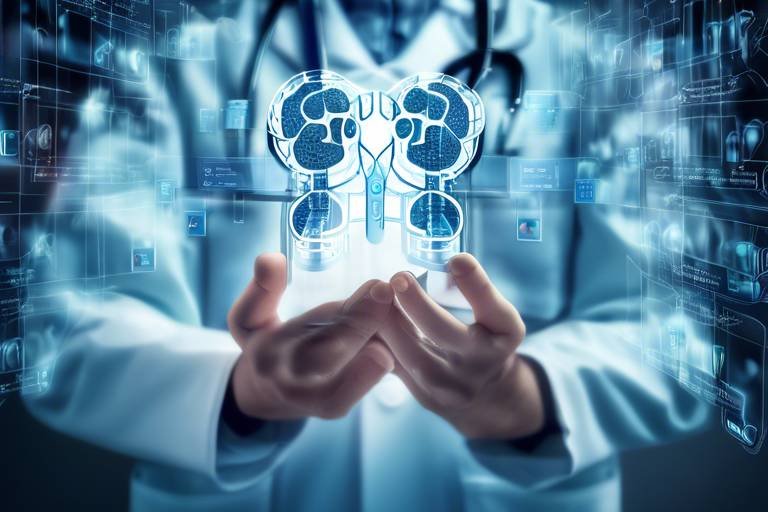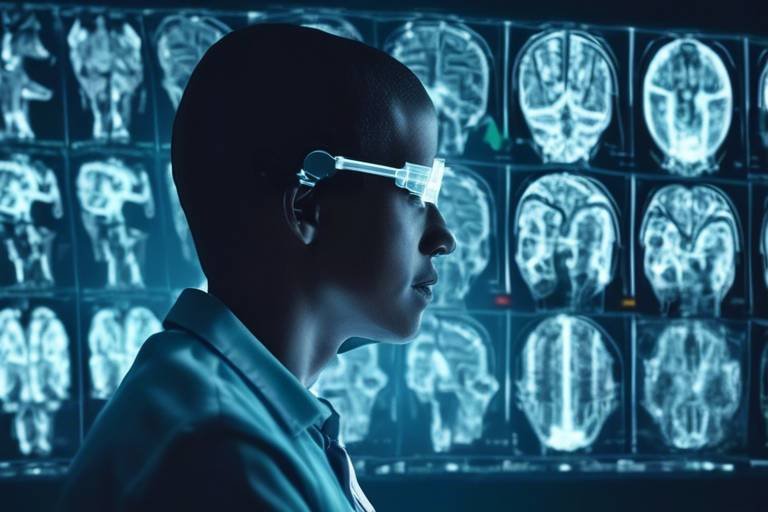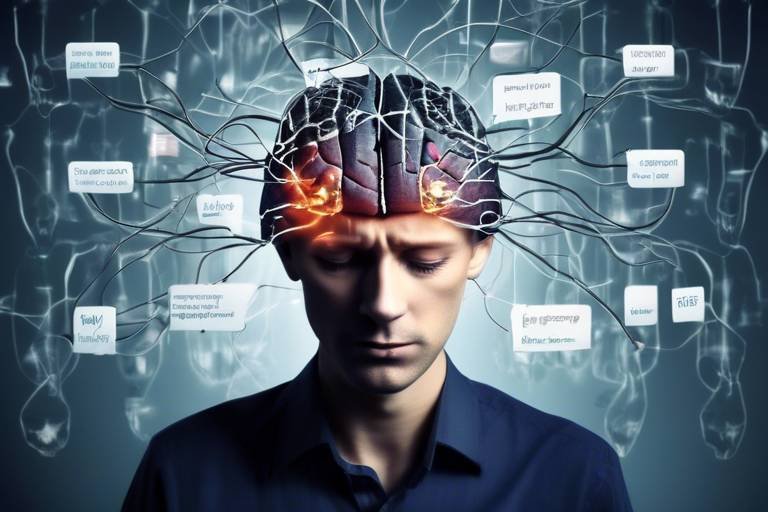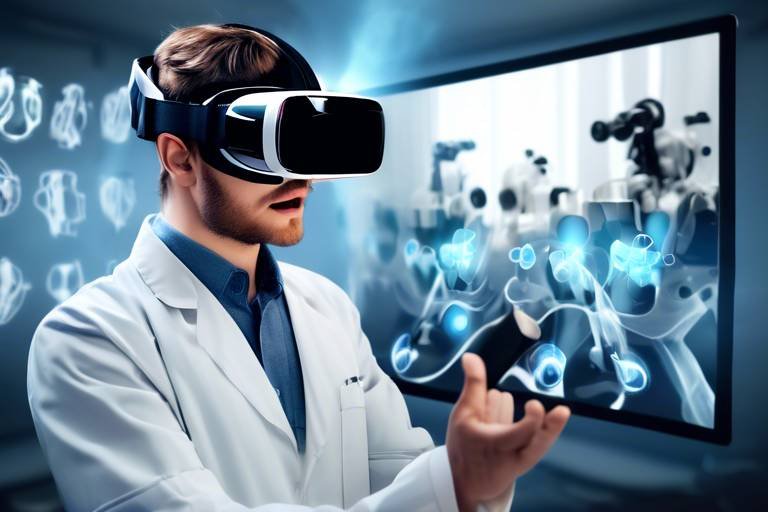The Role of Machine Learning in Healthcare Research
The landscape of healthcare is undergoing a seismic shift, and at the heart of this transformation is machine learning. This cutting-edge technology is not just a buzzword; it’s a powerful tool that is reshaping how we approach medical research and patient care. By leveraging vast amounts of data, machine learning algorithms can identify patterns and insights that are often invisible to the human eye. This capability is paving the way for improved diagnostics, personalized treatment plans, and enhanced patient outcomes. So, how exactly is machine learning influencing healthcare research? Let’s dive deeper into its applications, benefits, challenges, and what the future holds.
Machine learning, a subset of artificial intelligence, involves the development of algorithms that allow computers to learn from and make predictions based on data. In healthcare, this means analyzing everything from patient records to genetic data, leading to breakthroughs that were once thought impossible. Imagine a world where doctors can predict a patient’s risk of disease before symptoms even appear, or where treatments are tailored specifically to an individual’s genetic makeup. This is not science fiction; it’s the reality that machine learning is helping to create. Understanding the fundamentals of this technology is crucial for appreciating its role in healthcare research and its potential to revolutionize the field.
One of the most exciting applications of machine learning in healthcare is in the realm of diagnostics. Traditional diagnostic methods can be time-consuming and prone to human error. However, with machine learning, we can significantly enhance the accuracy and speed of disease identification. For instance, algorithms can analyze medical images to detect conditions such as tumors or fractures with remarkable precision. This not only aids healthcare professionals but also leads to earlier interventions, which can be life-saving. The implications for patient care are profound, as timely and accurate diagnoses can lead to better treatment strategies and improved health outcomes.
One area where machine learning shines is in image recognition and analysis. Radiologists and pathologists are increasingly relying on machine learning algorithms to assist in the interpretation of medical images. By automating image analysis, these technologies can detect anomalies that may be missed by the human eye, streamlining the diagnostic process. For example, machine learning can analyze X-rays, MRIs, and CT scans with incredible speed and accuracy, identifying issues such as tumors, fractures, or infections. This not only enhances the efficiency of healthcare providers but also improves patient outcomes by facilitating earlier diagnosis.
The benefits of automated imaging are numerous. First and foremost, it reduces the potential for human error, which can have devastating consequences in a medical setting. Additionally, machine learning algorithms can process and analyze images much faster than a human, leading to quicker diagnoses. This can be particularly crucial in emergency situations where time is of the essence. Furthermore, by providing consistent and objective analyses, machine learning can help standardize diagnostic processes across different healthcare facilities. In essence, automated imaging not only enhances the accuracy of medical imaging but also has the potential to save lives through early detection.
However, the journey towards fully automated imaging is not without its challenges. One significant hurdle is the quality of data. Machine learning algorithms rely heavily on the quality of the data they are trained on. If the data is biased or flawed, the outcomes can be misleading, potentially leading to incorrect diagnoses. Additionally, there is the issue of algorithm bias, where the algorithms may perform differently across diverse populations. Ongoing efforts are being made to address these challenges, including improving data collection methods and developing more inclusive training datasets. The goal is to ensure that machine learning can be a reliable asset in healthcare research and practice.
Predictive analytics is another exciting application of machine learning in healthcare. By analyzing historical patient data, machine learning algorithms can forecast patient outcomes and risks. This capability is invaluable in personalized medicine, where treatments can be tailored to an individual's unique health profile. Imagine a scenario where a doctor can predict a patient’s risk of developing a chronic illness based on their medical history and lifestyle choices. This proactive approach allows healthcare providers to intervene early, potentially preventing the onset of diseases and improving overall patient care.
Beyond diagnostics, machine learning is also making waves in the field of drug discovery. The traditional drug discovery process is often long, costly, and fraught with challenges. However, machine learning is helping to accelerate the identification of potential drug candidates by analyzing biological data and predicting how different compounds will interact with the body. This not only speeds up the process but also reduces costs significantly, allowing researchers to focus on the most promising candidates.
One of the key ways machine learning aids in drug discovery is by helping researchers identify new drug targets. By analyzing vast datasets of biological information, machine learning algorithms can uncover patterns and correlations that might not be visible through traditional research methods. This can lead to the development of novel therapies and treatments that address unmet medical needs. The implications for healthcare are enormous, as new and effective drugs can be brought to market more quickly, improving patient outcomes.
Additionally, machine learning enhances the design and execution of clinical trials. By predicting patient responses and improving recruitment strategies, machine learning can increase the efficiency and success rates of trials. This means that new treatments can be tested and brought to market faster, ultimately benefiting patients who are in need of innovative therapies. The integration of machine learning into clinical trials represents a significant step forward in the quest for effective and timely medical solutions.
- What is machine learning in healthcare? Machine learning in healthcare refers to the use of algorithms and statistical models to analyze medical data, enabling improved diagnostics, treatment plans, and patient outcomes.
- How does machine learning improve diagnostics? Machine learning enhances diagnostics by automating image analysis and identifying patterns in data that help detect diseases earlier and more accurately.
- What are the challenges of using machine learning in healthcare? Challenges include data quality issues, algorithm bias, and the need for comprehensive training datasets to ensure reliable outcomes.
- How is machine learning used in drug discovery? Machine learning accelerates drug discovery by analyzing biological data to identify potential drug candidates and optimize clinical trial processes.

Introduction to Machine Learning in Healthcare
Machine learning is revolutionizing healthcare in ways that were once thought to be the stuff of science fiction. Imagine a world where computers can analyze vast datasets, uncovering hidden patterns that humans might miss. This is not just a dream; it’s happening right now! By harnessing the power of machine learning, healthcare professionals are able to improve diagnostics, tailor treatment plans, and ultimately enhance patient outcomes.
At its core, machine learning involves training algorithms to learn from data. This means that as more information is fed into the system, it becomes smarter and more accurate over time. In healthcare, this capability is particularly crucial. With the explosion of data generated from electronic health records, medical imaging, and genomic sequencing, machine learning provides the tools needed to make sense of it all.
Consider this: every day, healthcare providers are inundated with information. From patient histories to lab results, the volume can be overwhelming. Machine learning acts like a magnifying glass, allowing clinicians to zoom in on the most relevant data. It’s like having a personal assistant who not only organizes your notes but also highlights the most critical points and suggests the best course of action. This level of insight is invaluable in making informed decisions that can save lives.
Moreover, the applications of machine learning in healthcare are diverse and continually expanding. For example, algorithms can analyze medical images to detect early signs of diseases such as cancer, often with greater accuracy than the human eye. They can also predict patient outcomes based on historical data, allowing for personalized treatment plans that cater specifically to individual needs. In short, machine learning is not just a tool; it’s a game-changer in the quest for better health.
However, to truly appreciate the impact of machine learning in healthcare, it’s essential to understand its foundational concepts. Here are a few key points to consider:
- Data-Driven Insights: Machine learning thrives on data. The more quality data it has, the better its predictions and recommendations.
- Continuous Learning: As algorithms are exposed to new data, they adapt and improve, making them increasingly reliable over time.
- Interdisciplinary Collaboration: The integration of machine learning in healthcare requires collaboration between data scientists, healthcare professionals, and researchers.
In conclusion, the role of machine learning in healthcare research is not just about technology; it’s about enhancing human capabilities, improving patient care, and ultimately saving lives. As we delve deeper into this article, we will explore specific applications, benefits, and challenges that come with implementing machine learning in the healthcare landscape. Buckle up; it’s going to be an enlightening journey!

Applications of Machine Learning in Diagnostics
Machine learning is making significant strides in the field of diagnostics, fundamentally changing how healthcare professionals identify and treat diseases. By harnessing the power of algorithms and vast datasets, machine learning systems can assist in spotting patterns that may escape the human eye. This technology is not just about improving accuracy; it’s about enhancing the overall patient experience and outcomes. Imagine a world where diseases are detected at their earliest stages, where treatment is tailored specifically to each individual, and where healthcare providers have the tools to make informed decisions swiftly and effectively. Sounds like a dream, right? Well, it's becoming a reality!
One of the most exciting applications of machine learning in diagnostics is in the realm of image recognition and analysis. In radiology and pathology, machine learning algorithms can analyze medical images with remarkable precision. For instance, consider the case of a radiologist reviewing hundreds of X-rays or MRIs daily. The sheer volume can lead to fatigue and oversight. However, with machine learning, these images can be processed rapidly, enabling the detection of anomalies such as tumors or fractures that might be missed otherwise. This not only speeds up the diagnostic process but also significantly enhances the accuracy of results.
Image recognition technology powered by machine learning is enhancing the efficacy of diagnostic imaging. By automating the image analysis process, healthcare providers can focus on interpreting results rather than spending excessive time on preliminary evaluations. For example, algorithms can be trained to recognize specific patterns associated with various conditions, such as diabetes retinopathy in retinal images or lung cancer in chest X-rays. The implications for patient care are profound: earlier and more accurate diagnoses lead to timely interventions, which can be life-saving.
The benefits of automated imaging are numerous. First and foremost, it reduces human error, which is a critical factor in diagnostic accuracy. Additionally, it increases efficiency, allowing healthcare professionals to manage their time better and handle more patients. In a fast-paced environment like a hospital, every second counts. With machine learning enhancing the accuracy of medical imaging, the potential for saving lives through early detection becomes even more apparent. For instance, early-stage cancer detection can dramatically improve treatment success rates, offering patients a better chance at recovery.
However, as with any technological advancement, there are challenges to consider. The quality of data used to train these machine learning algorithms is paramount. If the data is biased or unrepresentative, the results can be misleading. Additionally, algorithm bias can lead to disparities in healthcare outcomes among different demographic groups. Ongoing efforts in healthcare research are focused on addressing these hurdles. Researchers are working to ensure that datasets are diverse and representative, and they are continually refining algorithms to minimize bias. The goal is clear: to create a diagnostic tool that is not only accurate but also equitable.
In summary, the applications of machine learning in diagnostics are transforming the landscape of healthcare. From enhancing image recognition capabilities to addressing the challenges of data quality, machine learning is paving the way for a future where diagnostics are faster, more accurate, and ultimately more effective. As we continue to explore these advancements, the potential for improved patient care and outcomes becomes increasingly exciting.
- What is machine learning in healthcare?
Machine learning in healthcare refers to the use of algorithms and statistical models to analyze and interpret complex medical data, enabling improved diagnostics, treatment plans, and patient outcomes.
- How does machine learning improve diagnostics?
Machine learning improves diagnostics by automating the analysis of medical images, identifying patterns, and reducing human error, which leads to earlier and more accurate disease detection.
- What are the challenges of using machine learning in diagnostics?
Challenges include data quality, algorithm bias, and the need for diverse datasets to ensure equitable healthcare outcomes.

Image Recognition and Analysis
In the realm of healthcare, powered by machine learning is proving to be a game-changer. Imagine a world where radiologists can instantly identify abnormalities in X-rays or MRIs with the help of advanced algorithms. This technology is not just a futuristic dream; it is happening right now! By automating the image analysis process, machine learning enhances the accuracy and speed of diagnostics, leading to better patient outcomes.
The core of this transformation lies in the ability of machine learning algorithms to learn from vast datasets of medical images. These algorithms are trained on thousands, if not millions, of images, allowing them to recognize patterns that may be invisible to the human eye. For instance, they can detect subtle differences in tissue density or identify early signs of diseases such as cancer, often before they become clinically apparent. This ability to detect anomalies quickly and accurately can be the difference between life and death for many patients.
One of the most significant advantages of automated imaging is its potential to reduce human error. In a field where a single mistake can lead to misdiagnosis, the precision of machine learning algorithms is invaluable. To illustrate this, consider the following benefits:
- Increased Efficiency: Automated systems can analyze images much faster than humans, allowing healthcare professionals to focus on patient care rather than getting bogged down in paperwork.
- Consistency: Unlike humans, algorithms do not suffer from fatigue, ensuring that every image is analyzed with the same level of scrutiny.
- Early Detection: The ability to identify diseases in their infancy can lead to earlier interventions, which are often less invasive and more effective.
However, the journey towards fully automated imaging is not without its challenges. One of the primary hurdles is data quality. Machine learning algorithms rely heavily on the quality of the data they are trained on. If the training images are of poor quality or not representative of the general population, the algorithms may produce biased or inaccurate results. Additionally, there is the issue of algorithm bias, where the algorithms may learn to favor certain demographics over others, leading to disparities in care. Ongoing research is focused on addressing these issues, ensuring that machine learning can be a tool for equity in healthcare.
In conclusion, the integration of machine learning in image recognition and analysis holds immense promise for the future of healthcare. As technology continues to evolve, we can expect to see even more sophisticated applications that will not only enhance diagnostic accuracy but also significantly improve patient care. The synergy between human expertise and machine learning could lead to a new era in medicine, where the best of both worlds come together to save lives.

Benefits of Automated Imaging
Automated imaging powered by machine learning is not just a technological advancement; it's a game changer in the healthcare industry. Imagine a world where radiologists can focus more on patient care rather than spending countless hours analyzing images. This is becoming a reality thanks to the incredible benefits that automated imaging brings to the table. One of the most significant advantages is the reduction of human error. Traditional imaging analysis relies heavily on the expertise and judgment of healthcare professionals, which can sometimes lead to misdiagnoses. With machine learning algorithms, the likelihood of error is significantly decreased, as these systems can analyze images with unparalleled precision.
Moreover, the speed at which automated imaging can process data is remarkable. In emergency situations, every second counts. Automated systems can rapidly analyze scans and provide results almost instantaneously, allowing healthcare providers to make quicker decisions regarding patient treatment. This efficiency not only enhances patient care but also optimizes workflow in busy healthcare settings. For instance, studies have shown that hospitals utilizing automated imaging technology can reduce the time taken for diagnosis by up to 50%.
Another key benefit is the ability of machine learning to detect subtle patterns that might be invisible to the naked eye. For example, algorithms can identify minute changes in imaging data that could indicate the early stages of diseases like cancer. Early detection is crucial, as it often leads to better treatment outcomes. To illustrate, consider the following table showcasing the differences in detection rates between traditional methods and automated imaging:
| Condition | Traditional Detection Rate (%) | Automated Imaging Detection Rate (%) |
|---|---|---|
| Breast Cancer | 80 | 95 |
| Lung Nodules | 75 | 90 |
| Brain Tumors | 70 | 88 |
As we can see, the enhanced detection rates can lead to earlier interventions, which are often critical for successful outcomes. Furthermore, automated imaging systems continuously learn and improve over time. This means that as more data is fed into these algorithms, their accuracy and efficiency will only continue to grow. In essence, every scan analyzed contributes to a more robust and intelligent system, paving the way for innovations in diagnostics.
However, it’s important to note that while automated imaging systems offer substantial benefits, they are not meant to replace human expertise. Instead, they serve as powerful tools that complement the skills of healthcare professionals. By combining the strengths of both automated systems and human judgment, we can create a healthcare environment that prioritizes patient safety and quality care.
In summary, the benefits of automated imaging are vast and transformative. From reducing human error and increasing diagnostic speed to enhancing detection rates and continuously improving through machine learning, these technologies are reshaping the landscape of healthcare diagnostics. As we look to the future, it's clear that automated imaging will play a crucial role in enhancing patient care and advancing medical science.
- What is automated imaging? Automated imaging refers to the use of machine learning algorithms to analyze medical images for diagnostic purposes.
- How does automated imaging reduce human error? By relying on algorithms that analyze images with high precision, automated imaging minimizes the risk of misdiagnosis often associated with human judgment.
- Can automated imaging replace radiologists? No, it is designed to assist radiologists by providing them with more accurate data, allowing them to focus on patient care.
- What are the future prospects of automated imaging? The technology is expected to evolve, becoming even more accurate and efficient, ultimately leading to better patient outcomes.

Challenges in Image Analysis
While the integration of machine learning in image analysis offers a plethora of advantages, it also presents a unique set of challenges that must be navigated to fully realize its potential in healthcare. One of the most pressing issues is the quality of data. Machine learning algorithms rely heavily on large datasets to learn and make predictions. If the data fed into these systems is incomplete or biased, the outcomes can be misleading. For instance, a model trained on non-diverse datasets may fail to accurately diagnose conditions in underrepresented populations, leading to disparities in patient care.
Another significant challenge is the algorithmic bias that can arise during the training process. Bias can occur if the training data reflects existing prejudices or if the algorithms themselves are not designed to account for variability in patient demographics. This can result in certain groups receiving less accurate diagnoses or treatment recommendations. Furthermore, as machine learning models become more complex, understanding how they arrive at specific decisions can become increasingly difficult, leading to a lack of transparency in the diagnostic process.
Moreover, the interpretability of machine learning models poses a challenge in clinical settings. Healthcare professionals need to trust and understand the recommendations made by these algorithms. If a machine learning system suggests a diagnosis but cannot explain how it arrived at that conclusion, medical practitioners may be hesitant to rely on its findings. This is particularly critical in high-stakes environments where patient lives are on the line.
To address these challenges, ongoing research is focusing on improving data collection methods, enhancing algorithm transparency, and developing standards for evaluating machine learning systems in healthcare. For example, ensuring that datasets are diverse and representative can help mitigate bias. Additionally, employing techniques that enhance the interpretability of algorithms can foster trust among healthcare providers.
In summary, while machine learning has the potential to revolutionize image analysis in healthcare, it is essential to tackle these challenges head-on. By prioritizing data quality, addressing algorithmic bias, and enhancing interpretability, we can pave the way for more reliable and equitable healthcare solutions.
- What is machine learning in healthcare? Machine learning in healthcare refers to the use of algorithms and statistical models to analyze medical data, allowing for improved diagnostics, treatment plans, and patient outcomes.
- How does machine learning improve diagnostics? Machine learning improves diagnostics by analyzing vast amounts of data to identify patterns and anomalies that may be difficult for human practitioners to detect.
- What are the main challenges of using machine learning in healthcare? The main challenges include data quality, algorithmic bias, and the interpretability of machine learning models.
- Can machine learning replace human healthcare providers? No, machine learning is designed to assist healthcare providers, not replace them. It enhances decision-making by providing data-driven insights.

Predictive Analytics in Patient Care
Predictive analytics is a game-changer in the realm of patient care, utilizing the power of machine learning to forecast patient outcomes and risks with remarkable precision. Imagine a world where doctors can anticipate health issues before they manifest, tailoring interventions to individual patients based on data-driven insights. This isn't just a futuristic dream—it's happening right now! By analyzing historical health data, predictive models can identify patterns that may indicate potential complications, enabling healthcare providers to intervene proactively.
One of the most significant benefits of predictive analytics is its role in personalized medicine. With the ability to analyze a patient's unique health history, lifestyle choices, and genetic information, healthcare professionals can develop customized treatment plans that are far more effective than one-size-fits-all approaches. For instance, consider a patient with a chronic condition like diabetes. Predictive analytics can help identify fluctuations in blood sugar levels before they become critical, allowing for timely adjustments in medication or lifestyle changes. This proactive approach not only improves patient outcomes but also enhances the overall efficiency of healthcare systems.
Moreover, predictive analytics can significantly reduce healthcare costs. By focusing on prevention rather than treatment, hospitals can minimize the need for expensive interventions and reduce the burden on emergency services. For example, a study showed that hospitals implementing predictive analytics could reduce readmission rates by up to 20%, translating to substantial savings for both healthcare providers and patients.
However, the implementation of predictive analytics in patient care isn't without its challenges. Issues such as data privacy, the need for high-quality data, and algorithmic bias must be addressed to fully realize its potential. Healthcare organizations must ensure that the data they collect is accurate and representative of diverse populations to avoid skewed predictions that could adversely affect certain groups. Ongoing research and collaboration between data scientists and healthcare professionals are essential in overcoming these hurdles.
In summary, predictive analytics is revolutionizing patient care by enabling personalized treatments, enhancing preventive measures, and ultimately improving patient outcomes. As technology continues to evolve, the integration of predictive analytics in healthcare will undoubtedly pave the way for a more proactive and efficient healthcare system.
- What is predictive analytics in healthcare?
Predictive analytics in healthcare involves the use of statistical techniques and machine learning to analyze historical data and predict future patient outcomes and risks.
- How does predictive analytics improve patient care?
By enabling healthcare providers to anticipate health issues before they arise, predictive analytics allows for personalized treatment plans and proactive interventions, ultimately improving patient outcomes.
- What are the challenges of implementing predictive analytics?
Challenges include ensuring data quality, addressing privacy concerns, and overcoming algorithmic bias to ensure accurate and equitable predictions.
- Can predictive analytics reduce healthcare costs?
Yes, by focusing on prevention and reducing the need for expensive treatments, predictive analytics can lead to significant cost savings for healthcare systems.

Machine Learning in Drug Discovery
Machine learning is reshaping the landscape of drug discovery, offering innovative solutions that accelerate the identification of potential drug candidates. Traditionally, drug development has been a lengthy and costly process, often taking over a decade and billions of dollars to bring a new drug to market. However, with the advent of machine learning, researchers can now analyze vast amounts of biological data at unprecedented speeds, enabling them to pinpoint promising compounds much more efficiently. This transformation is akin to finding a needle in a haystack, where machine learning algorithms act as powerful magnets, attracting the most relevant data and insights.
One of the key advantages of machine learning in drug discovery is its ability to process complex datasets, such as genomic sequences and chemical properties, to identify patterns that humans might overlook. For instance, algorithms can analyze the interactions between proteins and potential drug compounds, predicting which combinations are likely to be effective. This process not only speeds up the identification of drug candidates but also enhances the accuracy of predictions, reducing the risk of failure in later stages of development.
Moreover, machine learning can significantly reduce the time and costs associated with drug discovery. By streamlining the initial phases of research, such as screening and optimization, pharmaceutical companies can allocate resources more effectively. To illustrate this point, consider the following table that compares traditional drug discovery timelines with those enhanced by machine learning:
| Phase | Traditional Timeline (Years) | Machine Learning Enhanced Timeline (Years) |
|---|---|---|
| Target Identification | 2-4 | 1-2 |
| Lead Optimization | 3-5 | 1-3 |
| Preclinical Testing | 1-2 | 0.5-1 |
| Clinical Trials | 5-10 | 5-7 |
As the table demonstrates, machine learning can significantly shorten the timeline of drug discovery, allowing researchers to bring new therapies to patients faster than ever before. This acceleration is particularly crucial in urgent situations, such as the recent global health crises, where rapid drug development can save countless lives.
However, it's important to acknowledge that while machine learning presents incredible opportunities, it also comes with its own set of challenges. Issues such as data quality, algorithm bias, and the need for extensive validation can hinder progress. Researchers must ensure that the data used to train these models is not only abundant but also representative of diverse populations to avoid skewed results. Addressing these challenges is essential for the successful integration of machine learning in drug discovery.
In conclusion, machine learning is not just a passing trend in drug discovery; it is a powerful tool that is fundamentally changing how we approach the development of new therapies. By harnessing the power of algorithms, researchers can navigate the complexities of biological data with greater precision, ultimately leading to more effective treatments for patients. The future of drug discovery looks promising, with machine learning at the forefront, paving the way for innovations that could revolutionize healthcare.
- What is machine learning in drug discovery? Machine learning in drug discovery refers to the use of algorithms and statistical models to analyze biological data, facilitating the identification and optimization of potential drug candidates.
- How does machine learning improve drug development timelines? By automating data analysis and predicting outcomes, machine learning significantly reduces the time required for target identification, lead optimization, and preclinical testing.
- What challenges does machine learning face in drug discovery? Challenges include data quality issues, algorithm bias, and the need for extensive validation to ensure the reliability of predictions.
- Can machine learning replace traditional methods in drug discovery? While machine learning enhances traditional methods, it is not a complete replacement. It complements existing processes, improving efficiency and accuracy.

Identifying Drug Targets
In the realm of drug discovery, identifying the right drug targets is akin to finding a needle in a haystack. With the sheer volume of biological data generated today, machine learning emerges as a powerful ally in this quest. By leveraging advanced algorithms, researchers can sift through complex datasets to pinpoint potential targets that may have otherwise gone unnoticed. This capability not only streamlines the discovery process but also enhances the likelihood of developing effective therapies.
Machine learning techniques, such as supervised learning and unsupervised learning, play pivotal roles in analyzing vast biological datasets. For instance, supervised learning can be used to train models on known drug-target interactions, allowing these models to predict new interactions based on patterns identified in the training data. On the other hand, unsupervised learning can help uncover hidden structures in data, revealing novel targets that could be explored for therapeutic intervention.
Moreover, the integration of genomic, proteomic, and metabolomic data allows for a more comprehensive understanding of biological systems. This multi-omics approach provides a holistic view of the cellular environment, enabling researchers to identify drug targets that are not only relevant but also have a higher probability of success in clinical applications. For example, by analyzing gene expression profiles, machine learning algorithms can highlight genes that are overexpressed in certain diseases, suggesting them as potential targets for new drugs.
To illustrate the impact of machine learning on identifying drug targets, consider the following table that summarizes key methodologies and their implications:
| Methodology | Description | Implications |
|---|---|---|
| Supervised Learning | Uses labeled data to train models for predicting drug-target interactions. | Increases accuracy in identifying potential drug targets. |
| Unsupervised Learning | Analyzes unlabeled data to find hidden patterns and relationships. | Reveals novel targets that may not be evident through traditional methods. |
| Multi-Omics Integration | Combines genomic, proteomic, and metabolomic data for comprehensive analysis. | Enhances understanding of disease mechanisms and potential drug targets. |
Despite these advancements, challenges remain. The quality and completeness of data can significantly affect the outcomes of machine learning models. Furthermore, the complexity of biological systems means that not all identified targets will be viable for drug development. Therefore, continuous refinement of algorithms and validation through experimental studies are essential to ensure that the targets identified are not only promising but also feasible for therapeutic intervention.
As we look to the future, the potential for machine learning to revolutionize drug target identification is immense. With ongoing research and technological advancements, we can anticipate a new era of precision medicine where therapies are tailored to individual patients based on robust data-driven insights. This shift will not only enhance the efficiency of drug discovery but also improve patient outcomes, paving the way for a healthier future.
- What is a drug target? A drug target is a molecule, often a protein, that interacts with a drug to produce a therapeutic effect.
- How does machine learning improve drug discovery? Machine learning analyzes complex datasets to identify potential drug targets and predict their interactions with various compounds.
- What are the challenges of using machine learning in drug discovery? Challenges include data quality, algorithm bias, and the complexity of biological systems.

Optimizing Clinical Trials
In the ever-evolving landscape of healthcare, is a game changer, and machine learning is at the forefront of this transformation. Traditionally, clinical trials have been time-consuming and costly, often taking years to yield results. However, with the integration of machine learning algorithms, researchers can significantly enhance the design, execution, and analysis of these trials. Imagine a world where we can predict patient responses even before the trial begins—this is not just a dream; it's becoming a reality.
One of the most impactful ways machine learning optimizes clinical trials is through predictive modeling. By analyzing historical data, these algorithms can identify patterns and make informed predictions about how different patient demographics might respond to various treatments. This predictive capability allows researchers to tailor trials to specific populations, ensuring that the right patients are matched with the right therapies. For instance, if data shows that a particular demographic responds better to a specific drug, researchers can focus their recruitment efforts on that group, thereby increasing the likelihood of successful outcomes.
Additionally, machine learning can streamline the recruitment process. Finding eligible participants for clinical trials can be one of the most challenging aspects of the research process. Machine learning algorithms can sift through vast amounts of patient data to identify potential candidates who meet the trial criteria. This not only speeds up recruitment but also enhances the diversity of participants, which is crucial for the generalizability of trial results. By utilizing algorithms to analyze electronic health records, researchers can efficiently pinpoint individuals who may benefit from participation, thus accelerating the trial timeline.
Moreover, machine learning enhances the monitoring of patient data throughout the trial. Continuous data analysis allows for real-time insights into patient responses, side effects, and overall health. If a certain treatment is causing adverse effects in a subset of participants, the trial can be adjusted promptly, ensuring patient safety and ethical standards are upheld. This level of adaptability is unprecedented and can lead to more reliable and valid results.
However, it’s essential to acknowledge the challenges that come with integrating machine learning into clinical trials. Issues such as data privacy, algorithm bias, and the need for high-quality data can complicate the process. Researchers must navigate these hurdles carefully to ensure that the benefits of machine learning are fully realized without compromising ethical standards. As the field progresses, ongoing collaborations between data scientists, clinicians, and regulatory bodies will be crucial in addressing these challenges.
In conclusion, the role of machine learning in optimizing clinical trials cannot be overstated. By harnessing the power of predictive analytics and real-time data monitoring, researchers can enhance the efficiency, safety, and success rates of clinical trials. The potential for personalized medicine is vast, and as we continue to explore these innovative technologies, the future of clinical research looks brighter than ever.
- What is machine learning in clinical trials?
Machine learning in clinical trials refers to the use of algorithms to analyze data and predict patient responses, optimize recruitment, and monitor trial progress in real-time. - How does machine learning improve patient recruitment?
By analyzing electronic health records, machine learning can identify eligible participants more efficiently, ensuring a diverse and suitable patient population for clinical trials. - What are the challenges of using machine learning in clinical trials?
Challenges include data privacy concerns, algorithm bias, and the need for high-quality data to ensure accurate predictions and outcomes. - Can machine learning predict treatment outcomes?
Yes, machine learning can analyze historical data to predict how different patient demographics may respond to specific treatments, allowing for more tailored clinical trials.
Frequently Asked Questions
- What is machine learning in healthcare?
Machine learning in healthcare refers to the use of algorithms and statistical models to analyze and interpret complex medical data. It helps in discovering patterns and insights that can lead to improved diagnostics, treatment plans, and patient outcomes.
- How does machine learning improve diagnostics?
Machine learning enhances diagnostics by enabling early and accurate disease detection. Algorithms can analyze medical images, lab results, and patient data to identify anomalies that may be missed by human eyes, thus improving the overall quality of patient care.
- What are the benefits of automated imaging?
Automated imaging powered by machine learning reduces human error, increases diagnostic efficiency, and enhances the accuracy of medical imaging. This technology can lead to earlier detection of diseases, which is crucial for effective treatment and better patient outcomes.
- What challenges does automated imaging face?
Despite its advantages, automated imaging encounters challenges such as data quality issues and algorithm bias. Ensuring that the data used for training algorithms is diverse and representative is essential for minimizing these biases and improving the reliability of diagnostics.
- How does predictive analytics benefit patient care?
Predictive analytics utilizes machine learning to forecast patient outcomes and risks, allowing for personalized medicine approaches. By predicting how patients will respond to treatments, healthcare providers can tailor interventions to improve patient management and outcomes.
- In what ways is machine learning used in drug discovery?
Machine learning accelerates drug discovery by identifying potential drug candidates and optimizing the drug development process. It analyzes biological data to find new drug targets and enhances the design of clinical trials, making the entire process faster and more cost-effective.
- How does machine learning optimize clinical trials?
Machine learning optimizes clinical trials by predicting patient responses and improving recruitment strategies. This leads to more efficient trial designs and higher success rates, ultimately speeding up the availability of new therapies to patients.



















